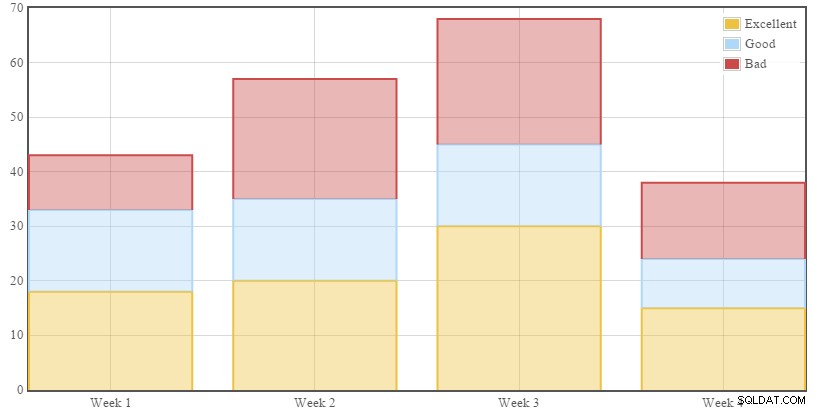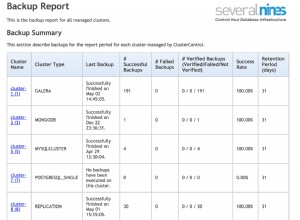Per aggiungere weeks/textual
dati sotto le colonne devi aggiungere il file delle categorie della libreria jquery.flot.categories.min.js alle tue risorse javascript.
Se ho capito bene, vuoi che il grafico assomigli a questo

Javascript
Devi aggiungere questi file in
<script src="//ajax.googleapis.com/ajax/libs/jquery/1.11.1/jquery.min.js"></script>
<script src="jquery.flot.min.js"></script>
<script src="jquery.flot.categories.min.js"></script>
<script src="jquery.flot.stack.min.js"></script>
e inizializza la libreria di cui parleremo $output dopo questo codice
<div id="placeholder" style="width:818px;height:413px" ></div>
<script type="text/javascript">
$(function() {
var series = [<?php echo $output; ?>];
$.plot("#placeholder", series, {
series: {
stack:true,
lines:{fill:true,show:false,steps:false},
bars: {
show: true,
barWidth: 0.8,
align: "middle",
},
},
xaxis: {
mode: "categories",
minTickSize: 1
}
});
});
PHP
Per prima cosa devi interrogare il database per trovare la data tra le date specificate, dopo aver ottenuto il risultato devi ordinare i dati per ogni settimana in un array
Ad esempio week One => 'good','good','bad','bad', 'week two' => and so on ...
dopodiché puoi usare array_count_values()
per contare il numero di occorrenze e costruire la colonna dei grafici.
Ho semplificato il codice usando le functions per semplificarti le cose
<?php
$con = mysqli_connect("localhost", 'root','','your db');
function getChartData($con, $startDate, $endDate){
$startDate = date("Y-m-d H:i:s", strtotime($startDate));
$endDate = date("Y-m-d H:i:s", strtotime($endDate));
$query = "SELECT * FROM `employees` WHERE `date` BETWEEN '$startDate' AND '$endDate'";
$result = mysqli_query($con, $query) or die ("Error: ".mysqli_error($con));
// a multidimenional array containing each week with it's
$weeksData = [];
// Group each week with it's data
while($row = mysqli_fetch_array($result)){
$weekNumber = date("W", strtotime($row['date']));
if(isset($weeksData[$weekNumber]))
{
$weeksData[$weekNumber][] = $row['level'];
}
$weeksData[$weekNumber][] = $row['level'];
}
// reset array indexes and sort the array
sort($weeksData);
$data = array();
// using array_count_values to count the number of (good, bad and excellent)
foreach ($weeksData as $key => $week) {
$data[$key] = array_count_values($week);
}
// return all the weeks with number of (good, bad and excellent) occurences
return $data;
}
// build the javascript object {data:['week num', occuerences]}
function buildColumn($data,$label, $numberOfWeeks)
{
$data = array_column($data,strtolower($label));
$balance = $numberOfWeeks - count($data);
if($balance !=0){
for($i=1;$i<=$balance;$i++) {
$data[] = 1;
}
}
$string = '{data: [';
foreach ($data as $key => $value) {
$weekNumber = $key+1;
$string .= '["Week '.$weekNumber.'",'.$value.'],';
}
$string = rtrim($string, ',');
$string .= "],valueLabels: {show: true,valign: 'middle'},label: '$label'}";
return $string;
}
function getNumberofWeeks($startDate, $endDate){
$weeks = array();
$period = new DatePeriod(new DateTime($startDate),
DateInterval::createFromDateString('+1 day'),new DateTime($endDate)
);
foreach ( $period as $dt ) {
$weeks[] = $dt->format( 'W' );
}
return count(array_unique($weeks));
}
ora puoi usare facilmente queste funzioni come questa
$numberOfWeeks = getNumberofWeeks($_POST['start'],$_POST['end']);
// get data of the last number of weeks
$chartData = getChartData($con, $_POST['start'],$_POST['end']);
// bulding columns data for each occurence
$badColumn = buildColumn($chartData,'Bad', $numberOfWeeks);
$goodColumn = buildColumn($chartData,'Good', $numberOfWeeks);
$excellentColumn = buildColumn($chartData,'Excellent', $numberOfWeeks);
// output {data: ...}, {data: ...},{data:....}
$output = "$excellentColumn , $goodColumn , $badColumn";
Esempio di lavoro completo
<!DOCTYPE html>
<html>
<head>
<title></title>
<script src="//ajax.googleapis.com/ajax/libs/jquery/1.11.1/jquery.min.js"></script>
<script src="jquery.flot.min.js"></script>
<script src="jquery.flot.categories.min.js"></script>
<script src="jquery.flot.stack.min.js"></script>
</head>
<body>
<?php
$con = mysqli_connect("localhost", 'root','','your db');
function getChartData($con, $startDate, $endDate){
$startDate = date("Y-m-d H:i:s", strtotime($startDate));
$endDate = date("Y-m-d H:i:s", strtotime($endDate));
$query = "SELECT * FROM `employees` WHERE `date` BETWEEN '$startDate' AND '$endDate'";
$result = mysqli_query($con, $query) or die ("Error: ".mysqli_error($con));
// a multidimenional array containing each week with it's
$weeksData = [];
// Group each week with it's data
while($row = mysqli_fetch_array($result)){
$weekNumber = date("W", strtotime($row['date']));
if(isset($weeksData[$weekNumber]))
{
$weeksData[$weekNumber][] = $row['level'];
}
$weeksData[$weekNumber][] = $row['level'];
}
// reset array indexes and sort the array
sort($weeksData);
$data = array();
// using array_count_values to count the number of (good, bad and excellent)
foreach ($weeksData as $key => $week) {
$data[$key] = array_count_values($week);
}
// return all the weeks with number of (good, bad and excellent) occurences
return $data;
}
// build the javascript object {data:['week num', occuerences]}
function buildColumn($data,$label, $numberOfWeeks)
{
$data = array_column($data,strtolower($label));
$balance = $numberOfWeeks - count($data);
if($balance !=0){
for($i=1;$i<=$balance;$i++) {
$data[] = 1;
}
}
$string = '{data: [';
foreach ($data as $key => $value) {
$weekNumber = $key+1;
$string .= '["Week '.$weekNumber.'",'.$value.'],';
}
$string = rtrim($string, ',');
$string .= "],valueLabels: {show: true,valign: 'middle'},label: '$label'}";
return $string;
}
function getNumberofWeeks($startDate, $endDate){
$weeks = array();
$period = new DatePeriod(new DateTime($startDate),
DateInterval::createFromDateString('+1 day'),new DateTime($endDate)
);
foreach ( $period as $dt ) {
$weeks[] = $dt->format( 'W' );
}
return count(array_unique($weeks));
}
// the number of weeks that you want to display in the chart
$numberOfWeeks = getNumberofWeeks($_POST['start'],$_POST['end']);
// get data of the last number of weeks
$chartData = getChartData($con, $_POST['start'],$_POST['end']);
// bulding columns data for each occurence
$badColumn = buildColumn($chartData,'Bad', $numberOfWeeks);
$goodColumn = buildColumn($chartData,'Good', $numberOfWeeks);
$excellentColumn = buildColumn($chartData,'Excellent', $numberOfWeeks);
// output {data: ...}, {data: ...},{data:....}
$output = "$excellentColumn , $goodColumn , $badColumn";
?>
<div id="placeholder" style="width:818px;height:413px" ></div>
<script type="text/javascript">
$(function() {
var series = [<?php echo $output; ?>];
$.plot("#placeholder", series, {
series: {
stack:true,
lines:{fill:true,show:false,steps:false},
bars: {
show: true,
barWidth: 0.8,
align: "middle",
},
},
xaxis: {
mode: "categories",
minTickSize: 1
}
});
});
</script>
</body>
</html>
Modifica
Basta sostituire queste due funzioni per renderlo compatibile con dd/mm/yyyy
function getChartData($con, $startDate, $endDate){
$startDate = explode('/', $startDate);
$startDate = $startDate[1] . '/' . $startDate[0] . '/' . $startDate[2];
$endDate = explode('/', $endDate);
$endDate = $endDate[1] . '/' . $endDate[0] . '/' . $endDate[2];
$startDate = date("Y-m-d H:i:s", strtotime($startDate));
$endDate = date("Y-m-d H:i:s", strtotime($endDate));
$query = "SELECT * FROM `employees` WHERE `date` BETWEEN '$startDate' AND '$endDate'";
$result = mysqli_query($con, $query) or die ("Error: ".mysqli_error($con));
// a multidimenional array containing each week with it's
$weeksData = [];
// Group each week with it's data
while($row = mysqli_fetch_array($result)){
$weekNumber = date("W", strtotime($row['date']));
if(isset($weeksData[$weekNumber]))
{
$weeksData[$weekNumber][] = $row['level'];
}
$weeksData[$weekNumber][] = $row['level'];
}
// reset array indexes and sort the array
sort($weeksData);
$data = array();
// using array_count_values to count the number of (good, bad and excellent)
foreach ($weeksData as $key => $week) {
$data[$key] = array_count_values($week);
}
// return all the weeks with number of (good, bad and excellent) occurences
return $data;
}
e
function getNumberofWeeks($startDate, $endDate){
$startDate = explode('/', $startDate);
$startDate = $startDate[1] . '/' . $startDate[0] . '/' . $startDate[2];
$endDate = explode('/', $endDate);
$endDate = $endDate[1] . '/' . $endDate[0] . '/' . $endDate[2];
$diff = strtotime($startDate, 0) - strtotime($endDate, 0);
return str_replace('-','', (int)floor($diff / 604800));
}




